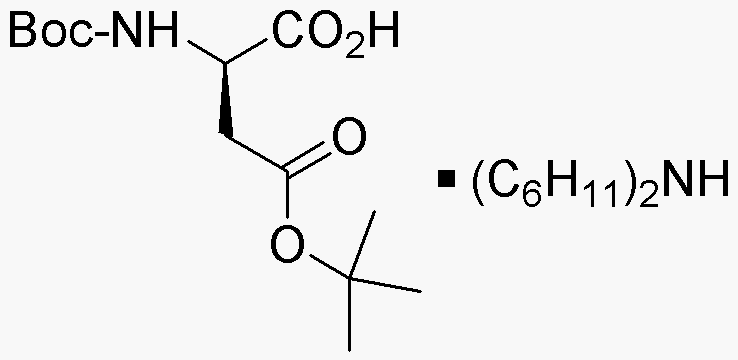Boc-D-aspartic acid b-tert-butyl ester dicyclohexylammonium salt is widely utilized in research focused on:
- Peptide Synthesis: This compound serves as a protecting group in peptide synthesis, allowing for the selective modification of amino acids without affecting other functional groups. This is crucial for creating complex peptides in pharmaceuticals.
- Drug Development: It plays a significant role in the development of new drugs, particularly in the design of neuroactive compounds that target specific receptors in the brain, enhancing therapeutic efficacy.
- Biochemical Research: Researchers use this compound to study metabolic pathways involving aspartic acid, providing insights into various biological processes and potential disease mechanisms.
- Protein Engineering: The compound is utilized in the modification of proteins to improve their stability and functionality, which is essential in biotechnology applications, such as enzyme production.
- Analytical Chemistry: It is employed as a standard in chromatography and mass spectrometry, helping to ensure accurate measurements and analysis of complex biological samples.
General Information
Properties
Safety and Regulations
Applications
Boc-D-aspartic acid b-tert-butyl ester dicyclohexylammonium salt is widely utilized in research focused on:
- Peptide Synthesis: This compound serves as a protecting group in peptide synthesis, allowing for the selective modification of amino acids without affecting other functional groups. This is crucial for creating complex peptides in pharmaceuticals.
- Drug Development: It plays a significant role in the development of new drugs, particularly in the design of neuroactive compounds that target specific receptors in the brain, enhancing therapeutic efficacy.
- Biochemical Research: Researchers use this compound to study metabolic pathways involving aspartic acid, providing insights into various biological processes and potential disease mechanisms.
- Protein Engineering: The compound is utilized in the modification of proteins to improve their stability and functionality, which is essential in biotechnology applications, such as enzyme production.
- Analytical Chemistry: It is employed as a standard in chromatography and mass spectrometry, helping to ensure accurate measurements and analysis of complex biological samples.
Documents
Safety Data Sheets (SDS)
The SDS provides comprehensive safety information on handling, storage, and disposal of the product.
Product Specification (PS)
The PS provides a comprehensive breakdown of the product’s properties, including chemical composition, physical state, purity, and storage requirements. It also details acceptable quality ranges and the product's intended applications.
Certificates of Analysis (COA)
Search for Certificates of Analysis (COA) by entering the products Lot Number. Lot and Batch Numbers can be found on a product’s label following the words ‘Lot’ or ‘Batch’.
Numéro de catalogue
Numéro de lot/série
Certificates Of Origin (COO)
This COO confirms the country where the product was manufactured, and also details the materials and components used in it and whether it is derived from natural, synthetic, or other specific sources. This certificate may be required for customs, trade, and regulatory compliance.
Numéro de catalogue
Numéro de lot/série
Safety Data Sheets (SDS)
The SDS provides comprehensive safety information on handling, storage, and disposal of the product.
DownloadProduct Specification (PS)
The PS provides a comprehensive breakdown of the product’s properties, including chemical composition, physical state, purity, and storage requirements. It also details acceptable quality ranges and the product's intended applications.
DownloadCertificates of Analysis (COA)
Search for Certificates of Analysis (COA) by entering the products Lot Number. Lot and Batch Numbers can be found on a product’s label following the words ‘Lot’ or ‘Batch’.
Numéro de catalogue
Numéro de lot/série
Certificates Of Origin (COO)
This COO confirms the country where the product was manufactured, and also details the materials and components used in it and whether it is derived from natural, synthetic, or other specific sources. This certificate may be required for customs, trade, and regulatory compliance.


